| Home | Nature Weekly Index |
20 December 2015 | White Heads | Eclipta prostrata |
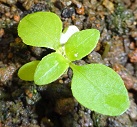 I had a White Heads or False Daisy (Eclipta prostrata)
growing in my pot recently. The lone seedling was first discovered in the early part of September. It grew fast
and by late September, its identity was quite clear. I was quite happy to have this herb growing in my pot. Many
months back, I did throw some seeds of this plant into the pot but nothing happened after several months and I
had forgotten about it.
I had a White Heads or False Daisy (Eclipta prostrata)
growing in my pot recently. The lone seedling was first discovered in the early part of September. It grew fast
and by late September, its identity was quite clear. I was quite happy to have this herb growing in my pot. Many
months back, I did throw some seeds of this plant into the pot but nothing happened after several months and I
had forgotten about it.
By early November, the first flower bud appeared. Subsequently, more flowers appeared and the plant was doing very well although it was not as bushy as those seen in the wild. Today, I counted a combined of 13 flowers, flower buds and ripen flower heads. Unlike some members of the Sunflower family (Asteraceae), the seeds of this plant are not disperse by wind but simply fell to the ground around the parent plant. With the fruiting plant, I was able to collect some seeds to have a closer look. The freshly collected elongated black seeds will turn light brown over time. The injured areas of its leaf will turn black quickly when exposed to air.
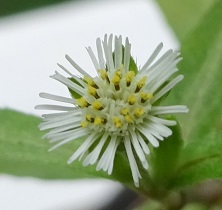
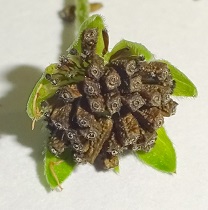
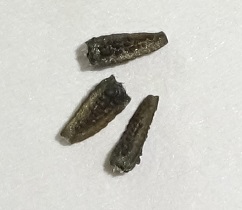
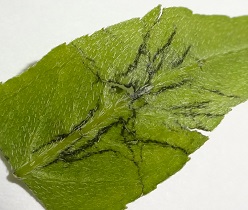
There were plenty of information on this plant online because of its medicinal value in traditional medicine. In traditional Chinese medicine, its official name is Ecliptae Herba. The most popular formulation that I found online was a combined herbal concoction known as Er Zhi Wan (Two Ultimate Pill, 二至丸). It contains equal portion of this herb with another herb, Nu Zhen Zi (Ligustrum lucidumis). Besides the Chinese population, this herb is also popular in India. In Ayurvedic medicine, it is called Bhringraj and many other local names. As far as its uses are concern, the range is broad and wide.
To better understand what exactly has been officially studied and reported on its medicinal use, I did a search in PubMed website using the search terms "Eclipta prostrata", "Eclipta alba", "Ecliptae Herba" and "Er Zhi Wan". Eclipta alba is a synonym of Eclipta prostrata. A total of 83 reports were identified. I had gathered the search results in tables in a webpage.
As with most traditional herbal medicines, there were very few studies done in human. In the series 83 reports, not a single study was conducted on human or patients.